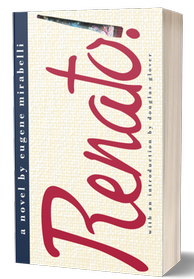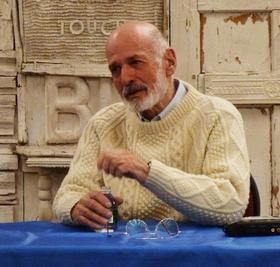I first encountered Eugene Mirabelli's work as a bookseller in the mid-'90s, when I picked up a novel called The World at Noon because of the cover design, then stayed for the words. In 2016, I had the chance to meet the author and his publisher, Bruce McPherson of McPherson & Co., during a launch event for Renato After Alba at the Book House of Stuyvesant Plaza in Albany, N.Y.
 Since then, a reimagining of Mirabelli's three Renato novels--The Goddess in Love with a Horse; Renato, the Painter; Renato After Elba--has occurred in the form of a recently published work, Renato! In his introduction, Douglas Glover writes: "It's rare to find a book, especially in our time, that so emphatically says yes to life, to the world as it comes."
Since then, a reimagining of Mirabelli's three Renato novels--The Goddess in Love with a Horse; Renato, the Painter; Renato After Elba--has occurred in the form of a recently published work, Renato! In his introduction, Douglas Glover writes: "It's rare to find a book, especially in our time, that so emphatically says yes to life, to the world as it comes."
I agree. Wanting to know more about this ambitious project that has been, quite literally, a lifetime in the making, I asked the people who made it happen.
McPherson noted that Mirabelli had published three well-received novels with major New York houses between 1959 and 1970, but wasn't making a living and began teaching at SUNY Albany. "When he found time to dedicate to writing fiction again in the '80s, he changed both his writing style and direction. Having a large, extended family of recent Italian/Sicilian immigrants in greater Boston, he could draw upon a endless fund of larger-than-life stories and eccentric relatives for inspiration; so he decided to write an ambitious cycle of books that would reflect and refract the experience of being born into and embracing one culture (America) while infused with another (Sicilian, Calabrian)."
The fictional Cavallù clan initially came to life in the novels The Language Nobody Speaks, The Passion of Terri Heart and The Goddess in Love with a Horse, published by Spring Harbor Press, which had been founded by Mirabelli and his late wife, Margaret.

|
|
| Eugene Mirabelli | |
"Each novel had major or minor characters related to characters in the other works," Mirabelli observed. "At the same time, I didn't want to impose on readers the necessity to read this or that earlier publication in order to make sense of whatever book they had in hand. So, though the characters in one novel may be related by friendship, marriage or blood, to characters in a different work, each of these is a stand-alone novel."
McPherson noted that the composition of Mirabelli's Renato novels over two decades "strikes me as highly unusual. For one thing, the difficulty of maintaining a single narrator's voice across an extended time period while composing non-sequentially is something of a high wire act. Renato's voice, by the way, is itself a work of genius--it sounds perfectly natural, psychologically complex, both revealing and possessing depth, and never forced or false. The impetus for writing each book was contained within the larger design of the interconnected cycle."
 |
|
| Bruce McPherson | |
Although his novels are stand-alones, Mirabelli said The Goddess in Love with a Horse has been "slightly re-written and reconfigured and used in Renato! as the way into Renato, the Painter, it has become Renato's genealogy. I never wrote it or intended it to be read that way. I conceived of it as the genealogy of a host of characters, not merely Renato.
"When Bruce suggested publishing in one volume the three novels that now compose Renato! I was astonished. It had never occurred to me to think of any of my novels actually bound between covers with any other of my works. I had been writing for years with the sense that this world of close or distantly related figures was complete in itself as it was. It seemed unnecessary to bring the stories together. Now, of course, I'm sorry that I can't get all the fictions together into one volume."
McPherson had thought The Goddess and Renato, the Painter "formed a perfect pair," but his "concern in 2011-12 was merely to publish the latter, and I assumed that that would be my sole involvement. What happened next is that Gene--who told me insistently in 2011 that his writing days were over--found himself working on a new book in 2012, one that would connect Renato's story to his own life through a particular life event, the death of one's spouse. But it is not autobiographical. So, sometime in 2015 Gene sent me a new manuscript, Renato After Alba, which is a short but very powerful narrative of loss and grief and triumph of the spirit. This, too, was designed both to be a narrative continuation of Renato, the Painter, and publishable as a stand-alone. This I published in 2016.
"Since the three Renato texts had grown out of each other, and were intended to be read together, the next step was to unite them physically in the new volume Renato! I wanted to issue a paperback that would be affordable for a broader audience, especially because it's nearly 600 pages. Although the texts already dovetailed, Gene needed to make various revisions, most of which involved eliminating redundancies and correcting some details. Once read in this form--a unified, complex novel--each of the individual parts of the book contributes a deep consequentiality to the one following and/or preceeding; and the result is a whole greater than the sum of its parts. Personally, I think it's a masterpiece of American life and a celebration of Everyman (and -woman)."

